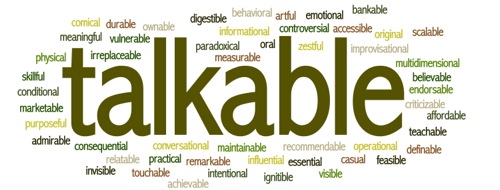The Talkable Brand video series continues…

Episode #15 | Talkable is Conversational
In this episode, you’ll learn talkable brands are talked about in two conversation channels, the offline channel and the online channel. The differences between these conversation channels are dramatic.
BONUS | Talkable is Conversational | script
Talkable brands are talked about in two conversation channels, the offline channel and the online channel. The differences between these conversation channels are dramatic.
Keller Fay TalkTrack® data clearly points out that 9 out of every 10 conversations people have about brands, happen in the offline channel of face-to-face and voice-to-voice conversations. Less than 10% of word of mouth conversations about brands happens online.
Dramatic differences in the motivations and articulations behind why people talk about brands in offline and online channels are just now being studied.
The authors of the ON BRANDS AND WORD OF MOUTH research paper outline the motivational drivers behind why people talk about brands in both the offline and online world.
This comprehensive study mixed, indexed, calculated, and analyzed brand-related word of mouth conversations from three distinct points: Keller Fay Talk Track® data for offline conversations, Nielsen-McKinsey Incite Buzzmetrics data for online conversations, and the Young & Rubicam Brand Asset Valuator for brand strength measurements.
According to the paper, our offline conversations are usually with people in personal, one-on-one situations — making it more appropriate to talk emotionally about matters.
And, our online conversations are usually with people in more public settings like Facebook and Twitter — thus, making it more of a channel to broadcast our uniqueness, expert knowledge, and passions.
That’s helpful information for us marketers but the biggest takeaway for us is the framework the authors have developed to outline the motivations behind why people talk in offline and online channels.
The authors have identified we talk about brands primarily because of these three drivers: Functional. Social. Emotional.
People engage in FUNCTIONAL conversations about brands to get information needed to make a decision and to better interpret the world around them.
We participate in SOCIAL conversations about brands to impress others, to express their uniqueness, and to increase their reputation.
People engage in EMOTIONAL conversations about brands because of excitement and love for some brands and disgust for other brands.
According to the deep analysis done by the authors of the study, our motivations to talk about brands differ depending on if we are talking to people in offline or online channels.
When talking with people face-to-face and voice-to-voice, we are motivated first by our EMOTIONAL trigger, then our FUNCTIONAL trigger, and thirdly, our SOCIAL trigger.
Our motivations to talk about brands Online differ in a significant way. Online, we are motivated first by our SOCIAL trigger, second by our FUNCTIONAL trigger, and thirdly by our EMOTIONAL trigger.
Since our offline conversations are usually with people in personal, one-on-one situations, it’s more appropriate for us to express emotions like amusement, admiration, and anxiety about brands.
It’s far more difficult for people to express a full range of emotions using words online rather than words and physical expressions in a verbal conversation. The tonality of our emotions gets lost in the translation when we write how we feel.
The online conversations we have about brands are usually with people out in the open on social networks and blogs. Because these conversations are in the open, online word of mouth is used more as a channel to broadcast our uniqueness, expert knowledge, and passions.
The marketing implications are simple.
If you have a brand or product that’s somewhat complicated and isn’t an impulse buy, focus your marketing efforts on getting current customers to tell their friends and friends of friends to spread word of mouth offline.
However, if your brand or product is trendy and can enhance one’s reputation, spend more time using online marketing activities to get people sharing and talking.
If you better understand why people are talking about your brand and where people are talking, you’ll be in a better place to design marketing activities in the right channel, offline or online, in order to make your brand more conversational to become more talkable.
BACKGROUND INFO:
The Talkable Brand video series will help you to strategically think about ways to make your brand, your business worthy of word of mouth. Every Tuesday on the Brand Autopsy blog a new episode will premiere giving you knowledge and a nudge. Knowledge being interesting information. The nudge being compelling motivation to make the information happen. The result, I hope, is helping you make brands more talkable.
EPISODE ARCHIVE:
| #01 | Achievable #02 | Believable #03 | Bankable #04 | Original #05 | Practical #06 | Paradoxical #07 | Artful #08 | Skillful #09 | Informational #10 | Comical | #11 | Loveable #12 | Functional #13 | Social #14 | Emotional |